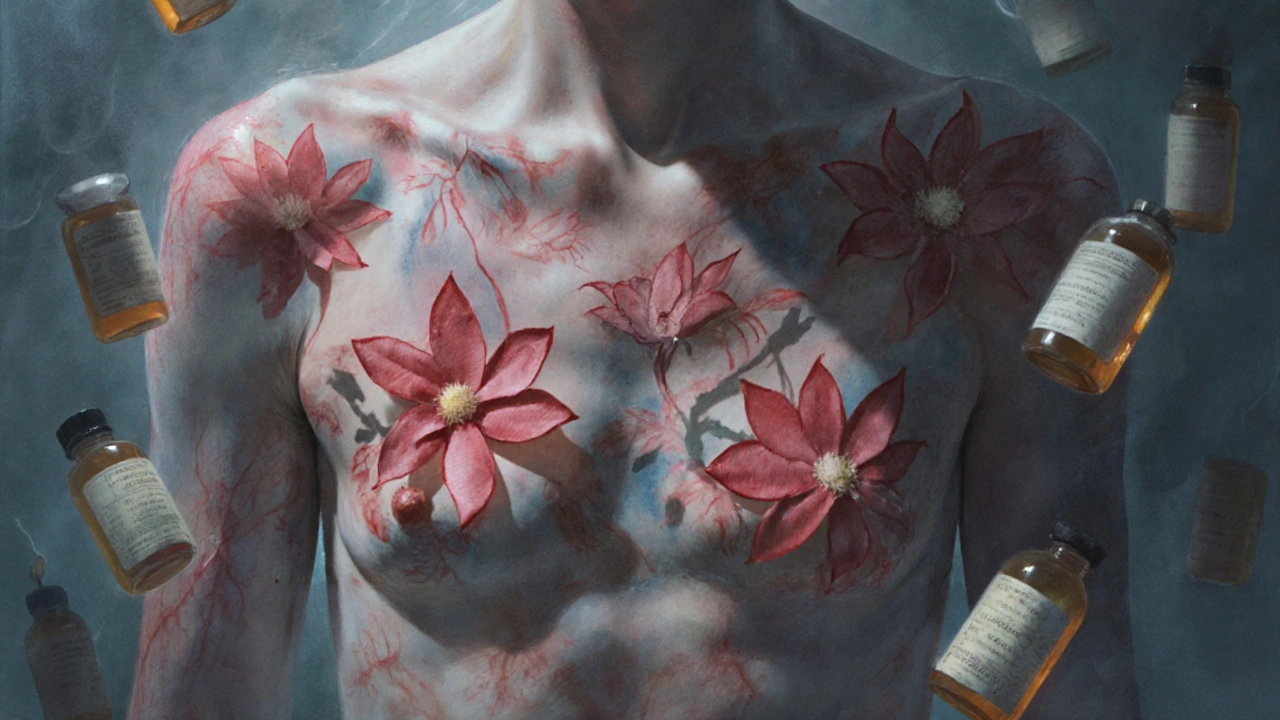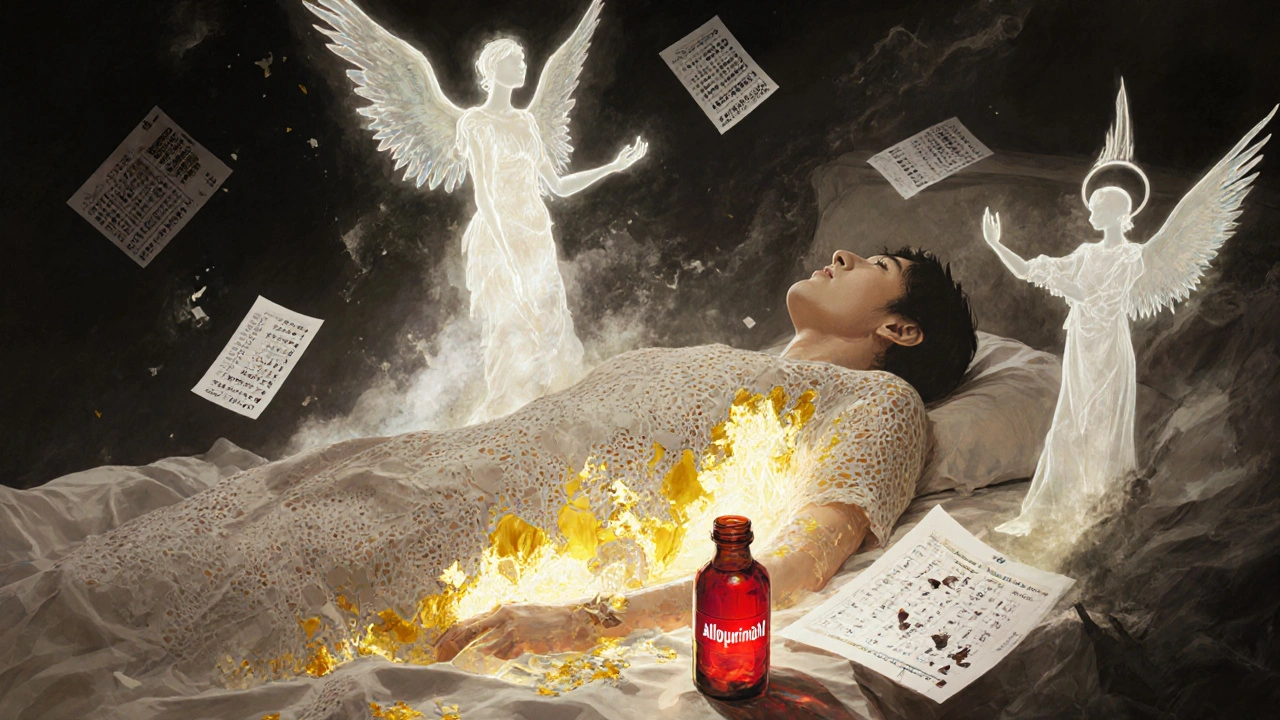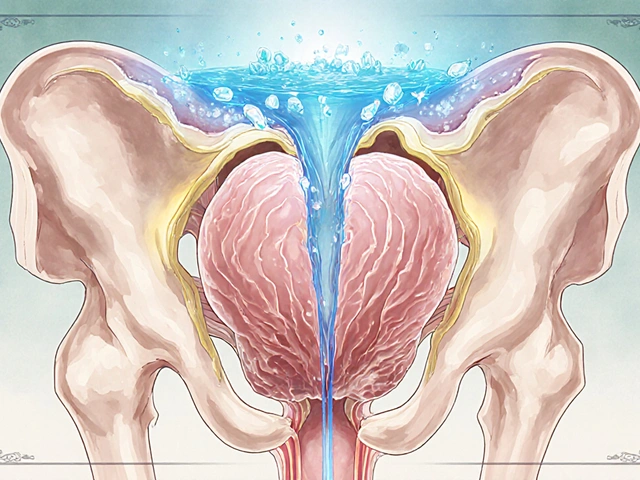
Medication Rash Emergency Checker
Check Your Rash
This tool helps you determine if your rash requires immediate medical attention based on symptoms described in the article.
Step 1: Describe Your Rash
Step 2: Symptom Check
Step 3: Additional Context
Emergency Assessment
Next Steps:
When you start a new medication, you expect relief - not a red, itchy, painful rash spreading across your chest or arms. But drug-induced dermatitis is more common than most people realize. About 2 to 5% of all adverse reactions to medicines involve the skin. For some, it’s just a mild annoyance. For others, it’s a warning sign of something life-threatening. Knowing what to look for - and what to do - can make all the difference.
What Does a Drug Rash Actually Look Like?
Not all skin reactions are the same. The most common type is a morbilliform rash - think measles-like spots. These are flat, red, slightly raised patches that usually show up on the trunk first, then spread to the arms and legs. They often appear 4 to 14 days after starting the drug, but sometimes don’t show up until you’ve stopped taking it. This delay trips up a lot of people. They think the rash came from something else - maybe a virus, new detergent, or stress - and miss the real cause. Then there’s urticaria, or hives. These are raised, itchy welts that come and go within hours. If they appear within an hour of taking a pill, it’s likely an IgE-mediated allergic reaction. These can be scary, especially if they’re paired with swelling of the lips or tongue, or trouble breathing. That’s an emergency. A less common but more dangerous form is Drug Reaction with Eosinophilia and Systemic Symptoms (DRESS). This isn’t just a skin problem. It’s a full-body reaction. You might get a rash, fever, swollen lymph nodes, and liver or kidney trouble. It usually shows up 2 to 6 weeks after starting the drug. The worst part? It can sneak up on you. You might feel fine for weeks, then suddenly crash. Common culprits include carbamazepine, phenytoin, lamotrigine, allopurinol, and certain antibiotics like sulfonamides. Another rare but serious type is Stevens-Johnson Syndrome (SJS) or Toxic Epidermal Necrolysis (TEN). These are medical emergencies. The skin starts to blister and peel off, like a severe burn. Mucous membranes - inside your mouth, eyes, genitals - can also be affected. Mortality rates range from 5% to 35%, depending on severity. If you’re losing skin in sheets, having trouble swallowing, or your eyes feel like they’re on fire, get to an ER immediately.Which Medications Are Most Likely to Cause Rashes?
Some drugs are notorious for triggering skin reactions. Penicillin and related antibiotics cause about 80% of all severe allergic skin reactions. Sulfonamides (like Bactrim) are next on the list. Antiseizure meds - carbamazepine, phenytoin, lamotrigine - are big offenders, especially in people with certain genetic markers. Allopurinol, used for gout, can trigger deadly rashes in people of Asian descent with the HLA-B*5801 gene. Even common over-the-counter drugs can be the culprit. NSAIDs like ibuprofen and naproxen cause non-allergic rashes in about 25% of cases. They don’t involve the immune system - they just irritate the skin directly. Then there’s hydrochlorothiazide, a diuretic often used for high blood pressure. It’s a major cause of photosensitivity rashes. If you’re on this drug and get a bad sunburn after minimal exposure, that’s a red flag. Topical meds can cause rashes too. Antibiotic creams, antifungal ointments, and even some sunscreen ingredients can trigger contact dermatitis. These usually show up right where you applied the product, but sometimes spread.Why Do Some People Get Rashes and Others Don’t?
It’s not random. Genetics play a huge role. If you’re of Southeast Asian descent and take carbamazepine, your risk of SJS is 1,000 times higher if you carry the HLA-B*1502 gene. In Han Chinese populations, HLA-B*5801 increases the risk of allopurinol-induced rashes by 580 times. Testing for these genes before prescribing is now standard in some countries - but not everywhere. Your immune system matters too. If you’ve had a viral infection like Epstein-Barr (mono) or HIV, and you’re prescribed an antibiotic like amoxicillin, your chance of developing a rash jumps 5 to 10 times. That’s why doctors avoid amoxicillin in people with mononucleosis - it’s not just a coincidence, it’s predictable. Age and polypharmacy are big factors. People over 65 who take five or more medications have a 35% lifetime risk of developing a drug rash. That’s compared to just 5% for someone on one or two pills. More drugs = more chances for a bad interaction. It’s not about being “sensitive” - it’s about probability.
What Should You Do If You Get a Rash?
First: don’t panic. Most rashes - about 90% - are mild and will go away within 1 to 2 weeks after stopping the drug. But don’t stop your medication on your own. If it’s for high blood pressure, epilepsy, or heart disease, stopping suddenly could be dangerous. Call your doctor. Take a photo of the rash. Note when it started, what you’ve been taking, and any other symptoms - fever, swelling, joint pain, fatigue. Your doctor will ask about timing. Did the rash start after you began the new drug? Did it worsen after a dose? Was it preceded by a viral illness? These details help pinpoint the cause. For mild rashes, your doctor might recommend:- Lukewarm baths with fragrance-free cleansers
- Applying fragrance-free moisturizer within 3 minutes of bathing
- Over-the-counter hydrocortisone 1% cream twice daily
- Oral antihistamines like cetirizine or loratadine for itching
When Is It an Emergency?
Go to the ER immediately if you have:- Widespread blistering or peeling skin
- Blisters in your mouth, eyes, or genitals
- Difficulty breathing or swallowing
- Facial swelling
- Fever over 38.5°C with rash
- Confusion, dizziness, or rapid heartbeat






Kathryn Ware
November 19, 2025 AT 03:01OMG I had a DRESS reaction to lamotrigine last year 😭 It started as a tiny rash on my chest, then I got a 103°F fever, my lymph nodes swelled like golf balls, and my liver enzymes went through the roof. I thought it was just a bad flu-until I passed out in the grocery store. Took 6 weeks of IV steroids and hospitalization. Now I carry a medical alert card. If you're on anticonvulsants and get ANY rash, don’t wait. Call your doctor TODAY. Seriously. My life changed because I ignored it for 3 days. 🙏
kora ortiz
November 21, 2025 AT 01:29Holli Yancey
November 22, 2025 AT 11:58I think this is one of the most important posts I've read all year. I never realized how much genetics play into drug reactions. My mom had a bad reaction to allopurinol and they never tested her for HLA-B*5801-she was Indian, and now I make sure my doctor runs that test before prescribing anything. It feels like such a simple thing to ask for, but so few people know about it.
Gordon Mcdonough
November 22, 2025 AT 16:23Jessica Healey
November 24, 2025 AT 02:52bro i took ibuprofen for a headache last month and woke up with this weird red patch on my neck like what the heck?? i thought it was a weird sunburn but then it spread and i freaked out and called my doc and they were like oh that's probably the NSAID. i thought those were safe?? now i'm scared to take anything. also why is everyone so chill about this?? like i'm not the only one right??
Levi Hobbs
November 25, 2025 AT 00:27Just want to add something important: if you’ve had a reaction to one drug in a class, avoid ALL drugs in that class. I had a mild morbilliform rash from sulfamethoxazole (Bactrim), and a year later, I took another sulfa drug for a UTI-thinking it was fine because it was ‘different.’ Nope. Got a full-blown hives reaction within 20 minutes. Now I carry a list of every drug class I can’t take. Even if the name sounds different, the chemical structure might not be. Ask your pharmacist. They know.
henry mariono
November 25, 2025 AT 23:25Thanks for sharing this. I’ve been on hydrochlorothiazide for 8 years and never realized sunburns were a red flag. I’ve always blamed the Florida sun. Now I’m checking with my doctor about alternatives. I appreciate the clarity on photosensitivity-it’s easy to overlook when you’ve been on a med so long.
Sridhar Suvarna
November 27, 2025 AT 03:02As a physician from India, I can confirm that HLA-B*5801 screening before allopurinol use is now mandatory in our national guidelines. We have seen a 70% reduction in fatal rashes since implementation. I urge Western countries to adopt similar protocols. Genetic predisposition is not a myth-it is a clinical reality that saves lives. Education and prevention are cheaper than ICU beds.
Joseph Peel
November 27, 2025 AT 07:47One thing missing from this excellent overview: the role of gut microbiome. Emerging research suggests that antibiotic use disrupts intestinal flora, which can dysregulate immune responses to subsequent drugs. A 2023 study in Nature showed patients with low microbial diversity were 3x more likely to develop delayed rashes. It’s not just the drug-it’s the body’s ecosystem. Probiotics may not prevent rashes, but they might reduce severity. Worth considering if you're on long-term meds.